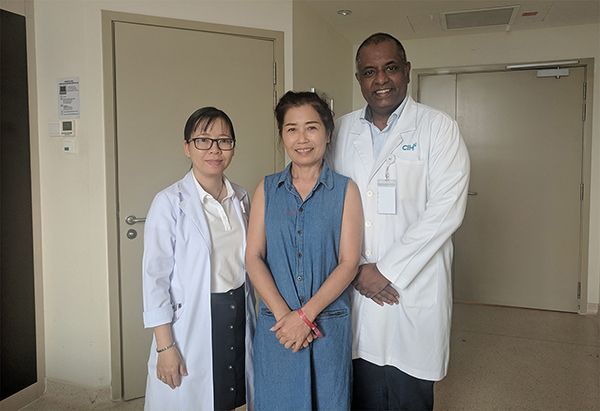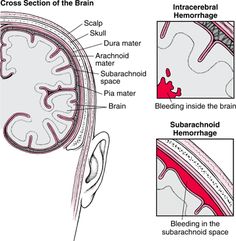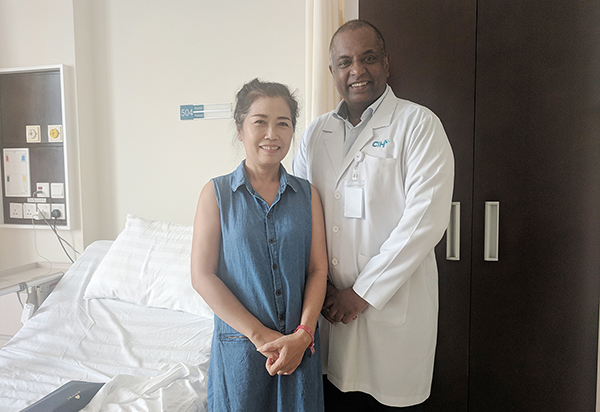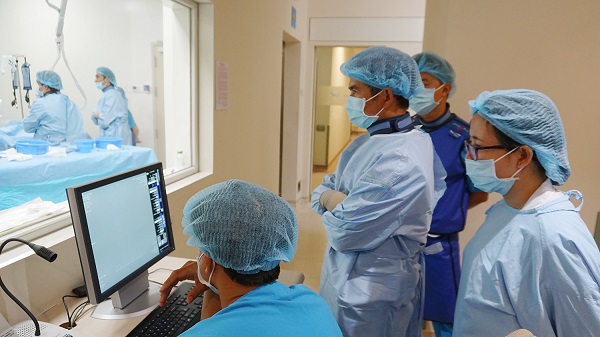When Ms. M.T.K.A, 58 had one of the worst headaches of her life she decided to have it checked out. She was shocked to find that she had a subarachnoid hemorrhage, a bleed on her brain. She chose CIH as she knew from friends that we have dedicated, international doctors that are specialized in treating this condition.
What happened in HOSPITAL?
We confirmed that Ms. M.T.K.A had a bleed in her head with a CT scan. This is a special type of X-ray which takes pictures of the brain from different angles. The scan can help to make the diagnosis of SAH and show the location of the hemorrhage, and problems it might be causing.
Because she had a bleed, she then had an angiogram done in The Angiosuite – Heart, Brain and Vascular Institute to see what has caused the bleeding in in her head. An angiogram is an x-ray test used to produce pictures of your blood vessels. A cerebral angiogram shows the blood vessels in your head and neck.

(left to right) Dr. Tran Thi Mai Thy-Neuroscience, Patient M.T.K.A and Dr. Mahen Nadarajah-Endovascular Neurosurgery
What is an SAH?
A/Prof. Dr. Mahen Nadarajah, Head of The Angiosuite-Heart, Brain & Vascular Institute at City International Hospital explained " A subarachnoid hemorrhage (hemorrhage = bleeding) is a sudden leak of blood over the surface of the brain. The brain is covered by layers of membranes, one of which is called the arachnoid layer. A subarachnoid hemorrhage (SAH) occurs beneath this layer (see picture below).

Most people have a sudden, severe headache, followed by vomiting (being sick). The headache usually persists and people tend to describe it as the worst headache they have ever had (a “thunderclap” headache). It is common to have a stiff neck. People might also slur their speech, experience a disturbance in their vision, have sensitivity to light, or have physical problems like a weakness in an arm or leg. In more severe cases, people can collapse and lose consciousness. Some people might also have a seizure (a “fit”)."

Ms. M.T.K.A got fully recovered and discharged on July 28, 2018
If No Vascular Abnormality Found
In many cases a cause is found for the SAH, such as an aneurysm (or blister) on the blood vessel wall. This then requires further treatment to prevent it from bleeding again.
However, in around 10% of cases no obvious blood vessel (vascular) abnormality is identified. In some cases we cannot find an underlying cause.
Some SAH without an aneurysm are called “perimesencephalic” hemorrhages, where the risk of a future hemorrhage is extremely low and the likelihood for a good recovery is high. This is what Ms. M.T.K.A had.
She was admitted to the hospital so that we can control the things that may cause her to have a re-bleed in the future such has her high blood pressure. A repeat scan was done after seven days to make sure that her bleeding had settled and there were no vascular abnormalities hiding.
She was then sent home fit and well and feeling much better as her headache had now almost completely settled. Our dedicated doctors and staff will now be following Ms. M.T.K.A’s progress to make sure she does not get another bleed in her head.
For appointment or more information about the services provided by The AngioSuite- Heart Brain & Vascular Institute, please contact:
The AngioSuite - Heart Brain & Vascular Institute
Patient services hotline: (8428) 6288 2228 or (8428) 6288 2227
Or Call City International Hospital
Operator: (8428) 6280 3333, ext. 8035 or 8036
? Address: Level 3, No. 3, 17A Street, Binh Tri Dong B Ward, Binh Tan Dist. (Next to AEON Mall
Binh Tan). Ho Chi Minh City.
? Website: https://cih.com.vn/en/
? Email: This email address is being protected from spambots. You need JavaScript enabled to view it.















